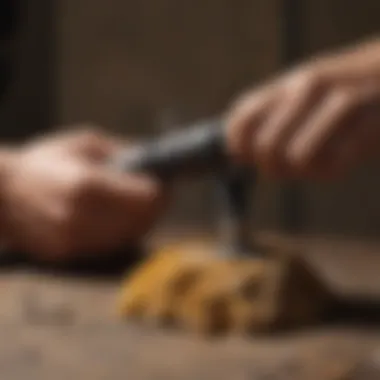Unveiling the Best Rock Polishing Compounds for Dremel Enthusiasts


Rock and Fossil Identification
As a rock and fossil collector looking to enhance your polishing process with a Dremel tool, it is crucial to start by understanding the types of rocks and fossils you will be working with. Identifying different rocks and fossils involves recognizing their distinct characteristics. Look for features such as color, texture, hardness, and any visible patterns or inclusions. Utilizing tools like magnifying glasses and geology hammers can aid in the identification process.
Collecting Tips and Techniques
Before delving into the world of rock polishing, it's essential to grasp best practices for collecting rocks and fossils. This includes seeking out prime collecting sites such as quarries, riverbeds, and areas with exposed geological formations. Ensure to follow ethical guidelines and local regulations when extracting specimens; safety should always be a top priority. Using tools like chisels, brushes, and safety goggles can help you securely gather your findings.
Preservation and Display
Once you have collected your rocks and fossils, preserving them effectively is key to maintaining their beauty and integrity. Techniques like cleaning with gentle brushes and water, and using preservatives can prevent deterioration. Proper storage methods involve keeping specimens in dry, cool environments to avoid damage. Additionally, consider creative display ideas such as shadow boxes, glass cases, or mounted plaques to showcase your collection.
Geological Insights
For a more in-depth appreciation of the rocks and fossils you work with, it's valuable to delve into the geological insights behind them. Explore the formations and processes that led to the creation of these specimens. Understand the historical significance of certain rocks and fossils, and be aware of notable discoveries in the field that have contributed to our understanding of the Earth's history.
Introduction
In the vast world of rock and fossil collecting, the importance of selecting the best rock polishing compound for a Dremel tool cannot be overstated. This article serves as a definitive guide for enthusiasts seeking to elevate their polishing techniques to unmatched levels of precision and quality. By delving into the nuances of rock polishing compounds, we aim to equip readers with the knowledge necessary to make informed decisions tailored to their specific needs and preferences. Whether you are a seasoned collector or a novice exploring the art of rock polishing, the insights presented in this article will undoubtedly enhance your polishing journey.
Understanding the Importance of Rock Polishing Compound
Understanding the pivotal role that a rock polishing compound plays in the overall polishing process is essential for achieving exceptional results. The choice of compound directly impacts the efficiency of abrasion, the quality of the finish, and the preservation of the rock's natural characteristics. Through careful consideration of factors such as abrasive grit size, mineral composition, and compatibility with Dremel tools, collectors can optimize their polishing workflow for optimal outcomes.
Benefits of Using a Dremel for Rock Polishing
The utilization of a Dremel tool for rock polishing offers numerous advantages that appeal to enthusiasts seeking precision and versatility. With its compact size, variable speed settings, and array of compatible attachments, the Dremel tool provides unparalleled control over the polishing process, allowing users to achieve intricate detailing and seamless finishing. Furthermore, the portability and ease of use of a Dremel make it a reliable companion for both indoor and outdoor rock polishing ventures.
Overview of the Article
This article serves as a comprehensive resource for rock and fossil collectors seeking to elevate their polishing capabilities. From elucidating the key factors to consider when selecting a rock polishing compound to providing an in-depth analysis of the top compounds available for use with Dremel tools, each section is meticulously crafted to offer valuable insights and practical guidance. By synthesizing a wealth of information into a cohesive narrative, this article aims to empower readers to make well-informed decisions and embrace the art of rock polishing with confidence.


Factors to Consider When Choosing a Rock Polishing Compound
When embarking on the journey of rock polishing with a Dremel tool, selecting the right polishing compound is crucial for achieving the desired results. Several key factors come into play when choosing a rock polishing compound to ensure a successful polishing process.
Firstly, considering the abrasive grit size is essential. The grit size determines the level of abrasiveness and the fineness of the polish achieved on the rock surface. It is important to match the abrasive grit size with the hardness of the rock being polished for optimal results. Different grit sizes are suitable for various types of rocks, so understanding this factor is paramount in selecting the right compound.
Secondly, the compatibility of the rock polishing compound with Dremel tools is another critical consideration. Not all compounds are suitable for use with Dremel tools, and using incompatible compounds can lead to inefficiency or even damage to the tool. Ensuring that the chosen compound is specifically designed for use with Dremel tools will guarantee a smooth and effective rock polishing process.
Lastly, the types of minerals being polished play a significant role in choosing the right rock polishing compound. Different minerals have varying levels of hardness and react differently to polishing compounds. By identifying the types of minerals you are working with, you can tailor your choice of polishing compound to suit the specific properties of the minerals, resulting in a successful polishing outcome.
By carefully considering these factors when selecting a rock polishing compound for your Dremel tool, you can enhance the efficiency and effectiveness of your rock polishing process, ultimately achieving impeccable results every time.
Abrasive Grit Size
The abrasive grit size of a rock polishing compound is a crucial factor that directly influences the quality of the polishing outcome. Abrasive grit size refers to the size of the abrasive particles within the compound, determining the level of abrasiveness and the smoothness of the polish achieved on the rock's surface.
When choosing a rock polishing compound for your Dremel tool, understanding the abrasive grit size is essential for achieving the desired level of polish. Different grit sizes are suitable for various types of rocks, with finer grit sizes producing smoother finishes, while coarser grit sizes are more abrasive and ideal for rougher surfaces.
It is important to match the abrasive grit size with the hardness of the rock being polished to ensure efficient polishing and avoid damaging the rock surface. By selecting the appropriate abrasive grit size based on the type of rock you are working with, you can optimize the polishing process and achieve a flawless finish that showcases the natural beauty of the rock.
Compatibility with Dremel Tools
The compatibility of a rock polishing compound with Dremel tools is a crucial consideration when choosing the right compound for your rock polishing projects. Using a compound that is specifically designed for use with Dremel tools ensures smooth operation and optimal performance during the polishing process.
Certain compounds may contain ingredients or properties that are not suitable for use with Dremel tools, potentially leading to inefficient polishing or damage to the tool itself. By selecting a polishing compound that is compatible with Dremel tools, you can rest assured that you are using a product that is specifically formulated to work seamlessly with your tool, maximizing efficiency and achieving professional-quality results.
Types of Minerals Being Polished
The types of minerals being polished play a significant role in determining the most suitable rock polishing compound for your Dremel tool. Different minerals have varying hardness levels and compositions, requiring specific types of compounds to achieve optimal polishing results.
By understanding the properties of the minerals you are working with, you can select a polishing compound that is tailored to the unique characteristics of those minerals. For example, softer minerals may require a finer polishing compound to achieve a smooth finish without causing damage, while harder minerals may benefit from a more abrasive compound to effectively polish the surface.
Considering the types of minerals being polished when choosing a rock polishing compound ensures that you are using the most appropriate product for the job, ultimately enhancing the quality and efficiency of your rock polishing process.


Top Rock Polishing Compounds for Dremel
When delving into the realm of rock polishing with a Dremel tool, the choice of polishing compound plays a pivotal role in achieving impeccable results. The selection of the right polishing compound can significantly impact the shine, clarity, and overall finish of your rocks and minerals. In this section, we will explore the top rock polishing compounds that are tailored for Dremel applications, shedding light on their specific benefits, considerations, and relevance within the realm of rock and fossil collectors.
Diamond Polishing Paste
Diamond polishing paste stands out as a premium choice for rock polishing with a Dremel due to its unparalleled hardness and abrasive properties. With micronized diamond particles embedded in a paste form, this compound is ideal for achieving a flawless mirror-like finish on a variety of minerals and gems. Its exceptional abrasiveness enables swift and efficient polishing, making it a popular option for professionals and enthusiasts seeking top-tier results. When using diamond polishing paste, it is essential to apply it evenly and in controlled amounts to maximize its polishing efficacy.
Cerium Oxide Polishing Compound
Cerium Oxide polishing compound is renowned for its versatility and effectiveness in achieving high-gloss finishes on various rocks and minerals. This compound is particularly favored for its ability to remove fine scratches and blemishes, resulting in a smooth and lustrous surface. With its ability to react chemically with the material being polished, cerium oxide offers a unique polishing action that enhances the final aesthetic of the specimen. When utilizing cerium oxide polishing compound, users should ensure proper ventilation due to its fine dust particles to maintain a safe and clean working environment.
Aluminum Oxide Polishing Compound
Aluminum oxide polishing compound is a cost-effective option that provides reliable results in enhancing the shine and clarity of rocks and minerals when used with a Dremel. Known for its durability and consistency in polishing various materials, this compound offers a balance between abrasive strength and finesse, making it suitable for both beginners and experienced polishers. Its versatility and ease of application make it a staple choice for a wide range of polishing projects, ensuring consistent and satisfactory outcomes with each use.
Silicon Carbide Polishing Compound
Silicon carbide polishing compound boasts exceptional hardness and abrasiveness, making it a go-to option for shaping and smoothing rocks and minerals with precision. This compound excels in removing material quickly while maintaining control over the polishing process, allowing for detailed polishing of intricate surfaces. Whether working on softer stones or harder minerals, silicon carbide polishing compound delivers consistent results and is prized for its efficiency in achieving desired polishing outcomes. When working with silicon carbide polishing compound, it is advisable to monitor the pressure and speed of the Dremel tool to optimize the polishing process effectively.
How to Apply Rock Polishing Compound with a Dremel
In the realm of rock and fossil collection, the application of rock polishing compounds with a Dremel tool is a crucial step in achieving stunning results. This section delves into the intricate process of applying these compounds effectively to elevate the appearance of rocks and fossils to a whole new level.
Preparing the Rock Surface
Before delving into the application of rock polishing compound with a Dremel, proper preparation of the rock surface is paramount. The surface must be cleaned thoroughly to remove any dirt, debris, or previous residues that could affect the polishing process. Inspection for cracks or imperfections is also essential to ensure a smooth polishing experience.
To prepare the rock surface adequately, begin by washing it with mild soap and water, ensuring all contaminants are removed. Next, dry the rock completely before proceeding to the application of the polishing compound. This meticulous preparation sets the foundation for a flawless polishing outcome.
Application Techniques
Mastering the application techniques plays a pivotal role in the efficacy of rock polishing with a Dremel. The key is to apply the right amount of compound evenly across the rock surface to achieve a consistent shine. Utilizing a soft cloth or polishing wheel attached to the Dremel, gently spread the compound in circular motions, ensuring comprehensive coverage.


It is vital to adjust the speed and pressure of the Dremel to match the hardness of the rock being polished. For softer rocks, a lower speed with light pressure is recommended to prevent damage, while harder rocks may require higher speed and slightly more pressure. Consistency and patience are essential during the application process to attain exceptional results.
Tips for Achieving a Mirror-Like Finish
To attain a mirror-like finish that mesmerizes onlookers, adherence to specific tips is imperative. Firstly, ensure that the compound is applied in multiple thin layers rather than a single thick layer to enhance the polishing effect. Additionally, periodically clean the polishing wheel or cloth to prevent compound buildup, optimizing its performance.
Moreover, incorporating a final buffing stage with a clean, dry cloth after the initial polishing can further enhance the sheen of the polished rock. This additional step ensures that any remaining residue is removed, leaving a lustrous and flawless finish. By following these meticulous tips, collectors can elevate their rock polishing endeavors to new heights of perfection.
Safety Precautions and Best Practices
In the realm of rock polishing, safety precautions and best practices are paramount to ensure a smooth and risk-free polishing experience. Rock polishing involves high-speed rotary tools and abrasive compounds that can pose risks if not handled with care. By understanding and implementing proper safety measures, rock and fossil collectors can protect themselves and prolong the lifespan of their equipment. This section delves into the essential elements, benefits, and considerations regarding safety precautions and best practices in the context of choosing the best rock polishing compound for a Dremel.
Wearing Personal Protective Equipment
When engaging in rock polishing activities with a Dremel tool, wearing personal protective equipment (PPE) is non-negotiable. PPE includes safety goggles to shield the eyes from flying debris, dust masks to prevent inhalation of harmful particles, and gloves to protect the hands from abrasive compounds. Additionally, wearing long-sleeved clothing and closed-toe shoes is advisable to minimize skin exposure to abrasives and prevent accidents. Investing in quality PPE not only safeguards the individual but also enhances overall polishing efficiency and comfort by instilling confidence and easing concerns about potential hazards.
Ventilation and Dust Control
Ventilation and dust control are crucial aspects of rock polishing that are often overlooked but are key in maintaining a safe and healthy working environment. Proper ventilation helps disperse airborne particles generated during the polishing process, reducing the risk of respiratory issues. Utilizing a dust collection system or working in a well-ventilated area with adequate airflow minimizes the concentration of particulates in the air, safeguarding both the polisher and the surrounding environment. Prioritizing ventilation and dust control not only enhances safety but also contributes to a cleaner and more organized workspace, promoting an efficient and enjoyable polishing experience.
Proper Storage and Handling of Polishing Compounds
Effective storage and handling of polishing compounds play a pivotal role in ensuring their longevity and maintaining their quality. Storing compounds in a cool, dry place away from moisture and direct sunlight prevents degradation and extends their shelf life. Properly sealing containers after use reduces the risk of contamination and ensures that the compounds remain effective for future polishing sessions. When handling polishing compounds, using designated tools and following manufacturer guidelines for application quantities helps prevent wastage and promotes cost-effectiveness. By prioritizing the proper storage and handling of polishing compounds, rock and fossil collectors can maximize the efficiency and effectiveness of their rock polishing endeavors.
Conclusion
The conclusion section of this article serves as the pivotal point where all discussed elements about choosing the best rock polishing compound for Dremel tools converge to provide a comprehensive understanding and direction for rock and fossil collectors. As we've delved into factors like abrasive grit size, compatibility with Dremel tools, and the types of minerals being polished – it becomes evident that the selection process is crucial for achieving optimal polishing results. This conclusion encapsulates the essence of the article, highlighting the critical role that rock polishing compounds play in enhancing the overall polishing process.
Furthermore, the importance of meticulous application techniques and safety precautions cannot be overstated. By emphasizing the significance of proper rock surface preparation, highlighting specific application techniques, and sharing tips for achieving a mirror-like finish, this conclusion aims to equip readers with the knowledge and insights necessary to elevate their rock polishing endeavors with a Dremel tool.
In essence, the conclusion serves as a guiding beacon, consolidating key takeaways and principles discussed throughout the article. It emphasizes the need for careful consideration when choosing a rock polishing compound, underscored by the benefits of using high-quality compounds for superior polishing results.
Final Thoughts on Choosing the Best Rock Polishing Compound for Dremel
In concluding thoughts, selecting the best rock polishing compound for Dremel tools is a decision that warrants thorough deliberation to ensure optimal outcomes. To achieve the desired mirror-like finish and enhance the overall aesthetics of rocks and minerals, factors such as the abrasive grit size, compatibility with Dremel tools, and the types of minerals being polished must be taken into account.
Moreover, safety precautions and best practices play a crucial role in the successful application of rock polishing compounds. By prioritizing the wear of personal protective equipment, implementing adequate ventilation and dust control measures, and adhering to proper storage and handling practices, rock and fossil collectors can safeguard both their well-being and the longevity of their polishing compounds.
This comprehensive guide endeavors to empower readers with the knowledge and expertise required to navigate the intricate world of rock polishing compounds effectively. By synthesizing key information and insights, it lays the foundation for informed decision-making, ensuring that enthusiasts maximize the potential of their Dremel tools for rock polishing endeavors.







